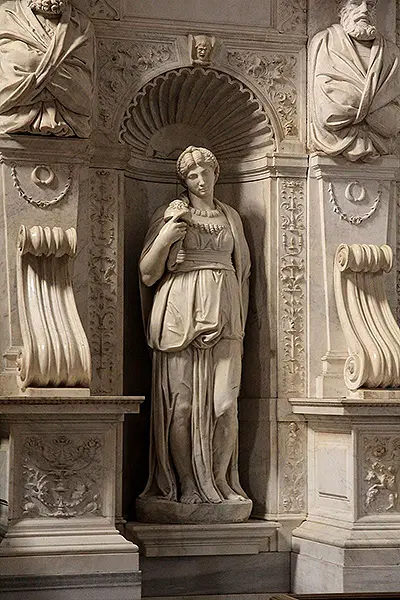Michelangelo would devote a long period of his career to the overall tomb design and construction, though in the four decades in which he was involved he was not working exclusively on this project. Typically, he would assign tasks to his assistants, enabling him to also take on other projects in order to satisfy his nationwide following. Rachel and Leah are believed to have marked the end of his time working on the tomb, and records have been uncovered which reveal more detail about his work here in the 1540s. Sadly, the two sculptures were not accepted with as much enthusiasm as Michelangelo might have hoped for, but perhaps that reflects the high level of expectation that surrounded his work by the time he was in his later years. The tomb can now be seen in person at the San Pietro in Vincoli, Rome, where it continually receives high levels of maintenance in order to protect it for future generations to enjoy. The Moses sculpture found alongside these two designs is a particularly popular attraction within this part of the Italian capital.
Leah, produced entirely in marble, is likely to have symbolised the power of work in leading a worthy life, whilst her sister sculpture, Rachel, is more aimed at the use of Faith for the same purpose. These pieces therefore sit together with a complementing nature that allows a comfortable relationship as they sit either side of Moses. Our knowledge of these two sculptures is relatively limited, with most still remaining untranslated from Italian, as most western historians have chosen to concentrate more on his better known artworks. The connection of Rachel and Leah to Moses ensures that they will never fall too far from the public's conscience, though, and both offer an important addition to his career, even though critical reception at the time of their unveiling was mixed. One must also make up their own minds around what each one specifically symbolise, as many other suggestions have also been put forward over the years.
Within the sculpture itself, Michelangelo displays Leah in Roman clothing, with a classical dress. In her right hand is an object, most likely a mirror to which she stares, or perhaps something to comb her long hair. Perhaps therefore she represents an active life, as some have claimed, but most will simply appreciate the aesthetic beauty of this piece, rather than worrying too much about the inspiration and symbolism that may or may not have lied behind the carefully crafted marble design. Michelangelo himself would have played an important role in the early stages of design but is known to have used the help of others in its final stages, where cleaning and polishing is involved. He would have learnt from years of experience about which parts of the development were critical to the finished piece, and which could be accomplished by anyone with sufficient technical knowledge and the right direction from himself.


